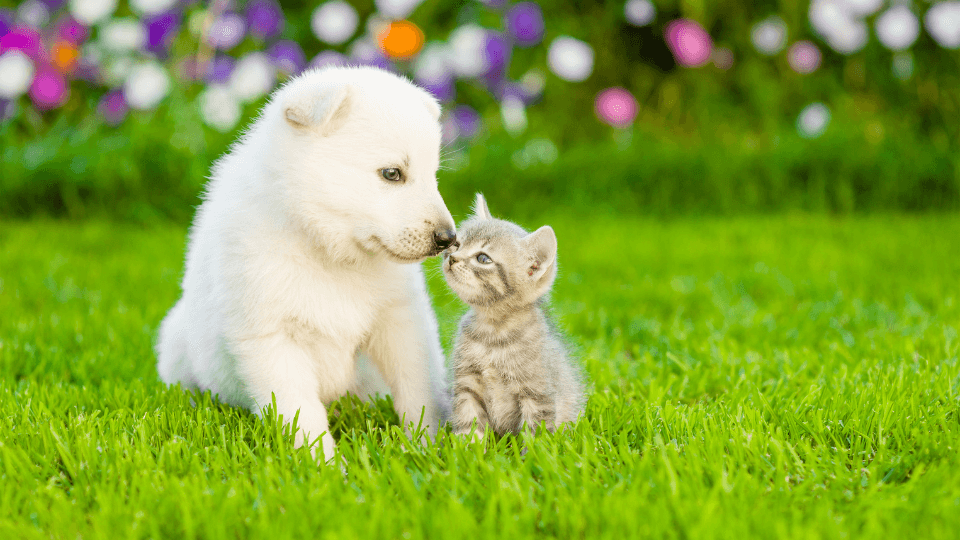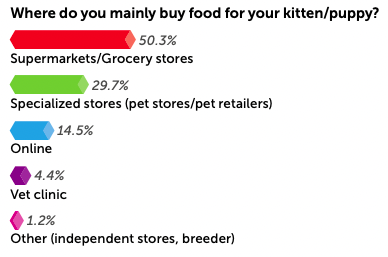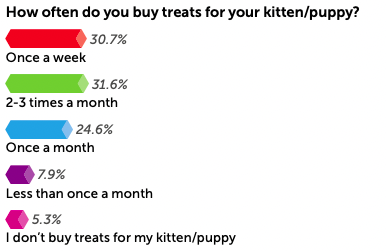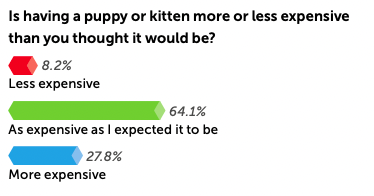Survey data shows puppy and kitten owner preferences and buying behavior

What are new pet parents’ habits? Where and how often do they buy? What types of products do they prefer? How do they think about their budget and future spending? We partnered with pet owner network Yummypets to find out.
Nearly half of the puppy and kitten owners consulted for this study predominantly feed their pets a combination of dry and wet food, with the second most popular option being dry food only (29%).
On the other hand, 9% of puppy and kitten parents give their youngsters a wet food-only diet. Only 1% give their puppy or kitten homemade food exclusively.
Brand loyalty
Most puppy and kitten parents (62%) consistently buy the same pet food brand, while 38% prefer to switch brands. This behavior is consistent across consumers in the different countries (US, Canada, France, Belgium and the UK). And there is no difference between different age groups.
Where do they buy?
Half of puppy and kitten parents make pet food purchases in the supermarket, whereas 29.7% go to pet stores and retailers. Not surprisingly, kitten parents buy food more often in the supermarkets, while puppy parents tend to get puppy food in specialized stores.
The third most popular channel is online, with 14.5% of consumers preferring this channel. Belgians are more likely to be part of this group, while only 7.1% of Canadian owners order pet food over the Internet.
A final geographical difference: UK puppy and kitten owners purchase pet food at supermarkets the most.
How often do they buy?
When asked how often they buy puppy or kitten food, the most common answer was 2 to 3 times a month (36%). Almost 30% buy food once a week, while 28% purchase once a month. Only 7% buy it less often.
UK puppy and kitten owners are more likely to purchase food for their pets once a week, possibly because they are more likely to get it while doing their regular groceries at a supermarket.
French respondents buy food for their puppies and kittens less often than owners in other countries. In addition, owners living in small towns and the countryside buy pet food less frequently than city dwellers.
Purchasing decisions
When deciding which pet food brand to buy, puppy and kitten owners consider many factors. But which factors are the most important? 27% of survey respondents say their top concern is the quality of ingredients.
Nearly 20% choose the life stage appropriate food as the number-one decision-making factor, while 19% rank a healthy recipe as their top reason for picking a brand.
Puppy and kitten parents are less concerned about cost (16%) and flavor (10%). Appealing packaging is one of the least important factors in their buying decisions (8%).
Treats
Pet parents are generous when it comes to giving treats to their puppies and kittens. Of the owners surveyed, 30.7% say they buy treats once a week. City dwellers, UK residents, and men are the most likely to purchase treats this often.
31.6% of puppy and kitten owners buy treats 2 or 3 times a month, while nearly one-quarter purchase them once a month. 7.9% buy treats less than once a month, and 5.3% never purchase them.
Older pet owners and pet owners living in France tend to buy treats for their puppies and kittens much less often than others, or not at all.
Soft/chewy treats are the most popular choice of puppy and kitten parents (48%), with dental treats ranking second (41%) and crunchy treats third (36%). Training treats come in fourth (31%), followed by bone treats (26%), jerky treats (24.4%), and lickable treats (20%).
Toys – a favorite purchase for pet owners
Many puppy and kitten parents, like those of human children, love to buy toys for their little ones.
Almost a quarter of pet parents (23.7%) buy toys for their puppies and kittens several times a month. Others (27.6%) buy them toys once a month or several times a year (35.5%).
US pet owners seem to be the ones who spoil their pets the most, as nearly 34% of them buy playthings several times a month. But not everyone seems to value toys as much: 2.3% of owners never buy toys for their puppies and kittens, while 7% purchase them once a year and 3% buy them less than once a year. French puppy and kitten parents buy toys for their pets less often than others.
Toys purchasing criteria
When choosing toys, the number one factor most often cited by puppy and kitten owners is the quality of their components (30.8%), followed by utility (25.8%). Older owners, and those living in the UK, care the most about the quality of a toy’s components. In contrast, French and Belgian owners are more likely to consider utility an important feature.
17.3% of puppy and kitten parents care the most about whether a toy is made of recycled components, while 16% are most concerned about price.
Just 5.2% of those who responded to the survey named the toy brand their top concern.
Finally, 4% are concerned about where toys for their puppies or kittens are manufactured, with men more likely to care than women.
Budget
Nearly 70% of respondents don’t have a pre-defined budget when shopping for their pets, and buy what they want as long as the prices are reasonable. This is particularly true for owners aged 65 years or older and those who live in the suburbs.
At the same time, 24% of owners are on a strict budget. Male respondents are more likely to fall into this category, as well as kitten owners in general. 6% of puppy and kitten owners say they purchase food and other items without considering prices.
Current and future spending
Most respondents (64.1%) say having a puppy or kitten is as expensive as expected, whereas 27.8% find the costs are higher than anticipated. Only 8.2% indicate that caring for their fur baby is cheaper than they thought.
Nearly 74% of puppy and kitten owners anticipate they will spend more on their pets in the future than they do at present.
However, Belgian and French owners are the exception here: they believe they will spend less on their pets over time.
Sources of information
The majority of owners (62.8%) list the Internet as a primary source of information about puppies and kittens before getting one. This was followed by word of mouth (48%), books/magazines (15%), and TV (12%). Younger generations are more likely to rely on online sources and TV.
After adopting their fur baby, puppy and kitten owners most often count on veterinarians for advice (58%). French and Belgian pet parents do so most frequently.
Overall, 14.1% of puppy and kitten owners rely on online research and websites for advice, with US and UK owners being the most likely to use this source of information.
Other primary sources of advice are friends and family (12.4%), trainers/behaviorists (5.6%), YouTube/social media (5.4%), and pet magazines (2%).
Product satisfaction
Most owners are happy with the number of puppy and kitten products available on the market. Nearly 42% indicate they are very satisfied, while 42% state they are satisfied.
Only 3% of respondents are dissatisfied. And less than 1% say they are very dissatisfied.





